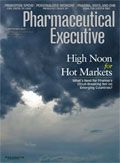Trying to Control Pharma Costs?
Pharmaceutical Executive
A key issue for biopharma marketers today is balancing cost and value factors around specialty biologic drugs, particularly those for cancer and other high profile, lifealtering diseases.
A KEY ISSUE FOR BIOPHARMA MARKETERS TODAY is balancing cost and value factors around specialty biologic drugs, particularly those for cancer and other high profile, life-altering diseases. The financial and reputational stakes for players in this hotly contested commercial space are high, compounded by a startling lack of awareness of the incentives that drive specific actions by payers, providers, health professionals, drug manufacturers—and, ultimately, the patient. Bridging this perception gap was the theme of Pharm Exec sister organization CBI's annual conference on Access and Reimbursement, held in Philadelphia earlier this month. Speaker after speaker noted that pharmacy spend is now the fastest growing cost segment for insurers, and specialty drugs are the principal factor.

William Looney
A highlight of the meeting was the release of a survey by a new community-based practitioner network, The Health Payer Council, examining how US payers are responding to access and financing challenges for specialty medicines. The council conducted interviews over a 10-day period in August with 52 US-based medical and pharmacy directors—whose decisions affect 60 million commercial policy lives. The objective was to identify what payers are doing at present to manage pharmaceutical costs and to assess cost control measures that are likely to be applied over the three years, particularly in the oncology space.
Here are three key findings:
- Current strategies emphasize the application of standard pharmacy benefit techniques to infused medicines and biologics, reflecting their higher visibility in terms of reimbursement exposure. Some 44 percent of the survey group have programs underway or in the pilot stages. Significantly, 39 percent are working on strategies to wean physician practices away from their dependence on revenues from these drugs—a difficult task in light of the fact that most oncology practices would be insolvent without the income from administered drug treatments. Especially relevant here is the offering of performance bonuses to physicians when plan-approved clinical treatment pathways are observed; 36 percent have this in place or under pilot. In lowest order of use are drug capitation/bundling and differential ASP reimbursement, at 31.2 percent and 21 percent, respectively.
- Overall, there was no ringing endorsement of the success of these approaches: the majority of plans consider their efforts to be only "somewhat successful." Pharmacy benefit management techniques (86 percent) were rated the highest in terms of success, followed by differential ASP reimbursement (67 percent). In contrast, efforts to wean physicians off of drug revenues received a high 17 percent score for being "somewhat unsuccessful." And no one was particularly enthusiastic about performance bonuses—a full 100 percent of the survey population ranked this tactic as "somewhat successful" rather than "very successful."
- A sea change is expected in management of oncology specialty drug spending over the next three years. More than two thirds—69 percent—believe aggressive cost controls targeting this therapeutic segment will be in place before mid-decade; half think this will happen over the next year. An interpretation of the poll results suggest in turn that capitation/bundling and pay for performance will be the toolkit of choice for cost cutters, since these two have captured the most interest among payers; they are seen as the most effective methods not currently in wide use.
Roger Green, an industry veteran who conceived and administers the Health Payer Council, tells Pharm Exec the survey evidences a "disconnect" between what payers are doing now to manage high drug costs in specialty and strategies that are not being applied—despite the perception that these are the ones most likely to be successful. "Payers by and large are still fixated on a philosophy that relies on the incentive of the carrot or the stick. This is not the optimal way to accomplish what is necessary to facilitate change, which is getting the various siloed parts of the system to cooperate, share, and work in partnership. More emphasis must be placed on changing basic behaviors." At root, Green says, is a simple lack of awareness. "No one in the system understands how anyone else makes money."
The council, which now has 107 members drawn from the medical director and pharmacy payer community, has a mandate to do just that. It won't make policy but is to serve as a forum to exchange information and build dialogue, with Big Pharma a principal focus. You might call it a Venn diagram of the payer community, writ real.

William Looney Editor-in-Chief wlooney@advanstar.com

Addressing Disparities in Psoriasis Trials: Takeda's Strategies for Inclusivity in Clinical Research
April 14th 2025LaShell Robinson, Head of Global Feasibility and Trial Equity at Takeda, speaks about the company's strategies to engage patients in underrepresented populations in its phase III psoriasis trials.
Beyond the Prescription: Pharma's Role in Digital Health Conversations
April 1st 2025Join us for an insightful conversation with Jennifer Harakal, Head of Regulatory Affairs at Canopy Life Sciences, as we unpack the evolving intersection of social media and healthcare decisions. Discover how pharmaceutical companies can navigate regulatory challenges while meaningfully engaging with consumers in digital spaces. Jennifer shares expert strategies for responsible marketing, working with influencers, and creating educational content that bridges the gap between patients and healthcare providers. A must-listen for pharma marketers looking to build trust and compliance in today's social media landscape.
Pfizer, GSK Gain ACIP Recommendations for RSV and Meningococcal Vaccines
April 18th 2025The Centers for Disease Control and Prevention’s Advisory Committee on Immunization Practices voted to expand access to Pfizer’s respiratory syncytial virus vaccine Abrysvo for high-risk adults in their 50s and voted in favor of GSK’s meningococcal vaccine, Penmenvy, for streamlined adolescent protection.